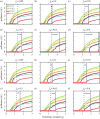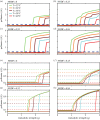Rising temperature drives tipping points in mutualistic networks
- PMID: 36756070
- PMCID: PMC9890100
- DOI: 10.1098/rsos.221363
Rising temperature drives tipping points in mutualistic networks
Abstract
The effect of climate warming on species' physiological parameters, including growth rate, mortality rate and handling time, is well established from empirical data. However, with an alarming rise in global temperature more than ever, predicting the interactive influence of these changes on mutualistic communities remains uncertain. Using 139 real plant-pollinator networks sampled across the globe and a modelling approach, we study the impact of species' individual thermal responses on mutualistic communities. We show that at low mutualistic strength plant-pollinator networks are at potential risk of rapid transitions at higher temperatures. Evidently, generalist species play a critical role in guiding tipping points in mutualistic networks. Further, we derive stability criteria for the networks in a range of temperatures using a two-dimensional reduced model. We identify network structures that can ascertain the delay of a community collapse. Until the end of this century, on account of increasing climate warming many real mutualistic networks are likely to be under the threat of sudden collapse, and we frame strategies to mitigate this. Together, our results indicate that knowing individual species' thermal responses and network structure can improve predictions for communities facing rapid transitions.
Keywords: climate warming; community collapse; ecological networks; mutualistic communities; tipping points.
© 2023 The Authors.
Conflict of interest statement
We declare we have no competing interests.
Figures








Similar articles
-
The sudden collapse of pollinator communities.Ecol Lett. 2014 Mar;17(3):350-9. doi: 10.1111/ele.12236. Epub 2014 Jan 6. Ecol Lett. 2014. PMID: 24386999
-
Evading tipping points in socio-mutualistic networks via structure mediated optimal strategy.J Theor Biol. 2023 Jun 21;567:111494. doi: 10.1016/j.jtbi.2023.111494. Epub 2023 Apr 17. J Theor Biol. 2023. PMID: 37075828
-
Predicting tipping points in mutualistic networks through dimension reduction.Proc Natl Acad Sci U S A. 2018 Jan 23;115(4):E639-E647. doi: 10.1073/pnas.1714958115. Epub 2018 Jan 8. Proc Natl Acad Sci U S A. 2018. PMID: 29311325 Free PMC article.
-
How does climate warming affect plant-pollinator interactions?Ecol Lett. 2009 Feb;12(2):184-95. doi: 10.1111/j.1461-0248.2008.01269.x. Epub 2008 Nov 26. Ecol Lett. 2009. PMID: 19049509 Review.
-
Mutualistic networks: moving closer to a predictive theory.Ecol Lett. 2019 Sep;22(9):1517-1534. doi: 10.1111/ele.13279. Epub 2019 Jun 26. Ecol Lett. 2019. PMID: 31243858 Review.
References
-
- Post E. 2013. Ecology of climate change: the importance of biotic interactions, vol. 68. Princeton, NJ: Princeton University Press.
-
- Fussmann KE, Schwarzmüller F, Brose U, Jousset A, Rall BC. 2014. Ecological stability in response to warming. Nat. Clim. Change 4, 206-210. (10.1038/nclimate2134) - DOI
Associated data
LinkOut - more resources
Full Text Sources

